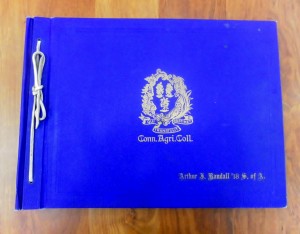Carey MacDonald is an undergraduate Anthropology major and writing intern. In her blog series Through the Lens of an Anthropologist, Carey analyzes artifacts found in the collections of Archives and Special Collections.
Although college customs tend to change over time, their social ramifications remain profound and everlasting. We are able to observe these traditions and their impact on students from such artifacts as documents, photographs, or, in this case, from scrapbooks.
The University Scrapbook Collection contains the scrapbook of one Arthur J. Randall who was a student at Connecticut Agricultural College from 1916 to 1918 when Charles L. Beach (of Beach Hall) was the college’s president. Randall’s scrapbook reflects his two years at C.A.C. in stunning detail and provides great insight into his personal college experience. Needless to say, this scrapbook also outlines C.A.C.’s very own history and traditions and highlights the agricultural roots of what is now the University of Connecticut.
Arthur J. Randall’s scrapbook is a wide, bound, bright blue book that was printed by The College Memory Book Company of Chicago, IL and copyrighted in 1914. It is called the “Memory and Fellowship Book” and is dedicated to the “Keepers of Keepsakes” in its inside title page. The Latin phrase “Qui Transtulit Sustinet,” or “He Who Transplanted Still Sustains,” is featured in gold on the front cover below a gold emblem. This same phrase is found on the Connecticut state seal, according to CT.gov. “Conn. Agri. Coll.” and Arthur’s full name and graduating year of 1918 are etched below the emblem. Also interestingly, the inside backing of the book shows the seals of several other American universities that must have also contracted out to The College Memory Book Company of Chicago. Ultimately, the scrapbook’s elaborate imagery and design are indicative of the significance of collegiate history and tradition.
Moreover, Randall’s scrapbook includes such things as class registration cards, treasurer’s cards, boarding and dining cards, Athletic Association season tickets, post office box renting fee slips, and other miscellaneous charge slips. He also kept many photographs of various buildings on campus, Horsebarn Hill, and his friends.
His scrapbook is, in essence, a repository of rather mundane items – but items that are nonetheless useful for our purposes. We can glean from Randall’s collection that he was likely a typical, responsible, self-aware student, by today’s standards at least, as well as by the standards of his time.
Also interesting is Randall’s account of the campus goings-on. First, he marks September 12, 1916 as “the beginning of my career” in the calendar section of his scrapbook. His “Comparative Athletic Record” shows that he played recreational basketball on several occasions. He notes the President’s Reception and Rope Pull – two traditional university events –in October of 1917, as well as the Halloween Masquerade, Benefit Dance for the Red Cross, and “first moving pictures” in November of the same year.
Randall also takes note of the fire that burned down the old chemistry building on the morning of November 27, 1917. This major change in the university setting was certainly upsetting, hence his note that it was a “total loss.” Essentially, in the academic year of 1917-18 Randall took note of many of the events he attended, which also included going to church services and Mansfield Grange meetings on a regular basis. It is particularly interesting that he recorded the events of his second year more than his first, and perhaps this is because he felt inclined to preserve what was left of his college career.
Lastly, Randall even held onto many of his final exams, the likes of which he also discusses in his calendar notes. By writing on January 21, 1918 about midyear exams that “to think of the next five days is enough to make you crazy,” Randall implies that the university view on exams was much like it is today: exams are stressful and throw everyone into a collective state of turmoil. His class schedules included classes such as Veterinary Science, Agriculture, Farm Management, Animal Husbandry (which he deemed ‘killer’), Dairy Husbandry, Horticulture, Forestry, History, and, interestingly, Military Drill and Military Science.
Randall’s records further identify the founding of the University of Connecticut as an agricultural school, and his apparent interest in recording exactly that indicates his pride in and appreciation for the school. It is from these roots that our university grew and diversified into the flagship research university that it is today.
Carey MacDonald, writing intern


I believe that was my Great Grandfather’s scrapbook. His military studies aligned with his brief participation in WWI efforts. He later had a dairy farm in the New Haven area. Thanks for posting!